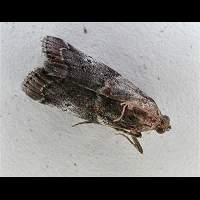Porphyry Knothorn Moth Trachycera suavella
At first sight and to the naked eye the Porphyry Knothorn Moth doesn't look very exciting. But as soon as you take out your magnifying glass or take a good close up picture this judgement changes. It turns out to be a very attractive dark silvery grey or sometimes even quite silvery moth. Also visible are some small whitish indented lines and a lot of red accents. It is quite similar to Trachycera marmorea, but usually darker and definitely bigger. However both species are very variable and hard to describe effectively. The wingspan of the Porphyry Knothorn Moth varies from 23 to 26mm.
The larvae become active in spring and eat the new shoots of the host plant. They weave galleries along the stem of the plant and young sprouts and eat from within these webs. In June they'll pupate in greyish cocoons made within the galleries or attached to them. The host plants are blackthorn mainly, but in gardens it often effects Cotoneaster.
The Porphyry Knothorn Moth flies in July and August. It is active during the night only, but comes to light. The species prefers sandy soils and occurs widespread in Southern England, but always is a rather local species. The same applies to the continent. It doesn't like the colder northern areas of the continent.
This species is still better known by its previous scientific name Numonia suavella.
At first sight and to the naked eye the Porphyry Knothorn Moth doesn't look very exciting. But as soon as you take out your magnifying glass or take a good close up picture this judgement changes. It turns out to be a very attractive dark silvery grey or sometimes even quite silvery moth. Also visible are some small whitish indented lines and a lot of red accents. It is quite similar to Trachycera marmorea, but usually darker and definitely bigger. However both species are very variable and hard to describe effectively. The wingspan of the Porphyry Knothorn Moth varies from 23 to 26mm.
The larvae become active in spring and eat the new shoots of the host plant. They weave galleries along the stem of the plant and young sprouts and eat from within these webs. In June they'll pupate in greyish cocoons made within the galleries or attached to them. The host plants are blackthorn mainly, but in gardens it often effects Cotoneaster.
The Porphyry Knothorn Moth flies in July and August. It is active during the night only, but comes to light. The species prefers sandy soils and occurs widespread in Southern England, but always is a rather local species. The same applies to the continent. It doesn't like the colder northern areas of the continent.
This species is still better known by its previous scientific name Numonia suavella.





